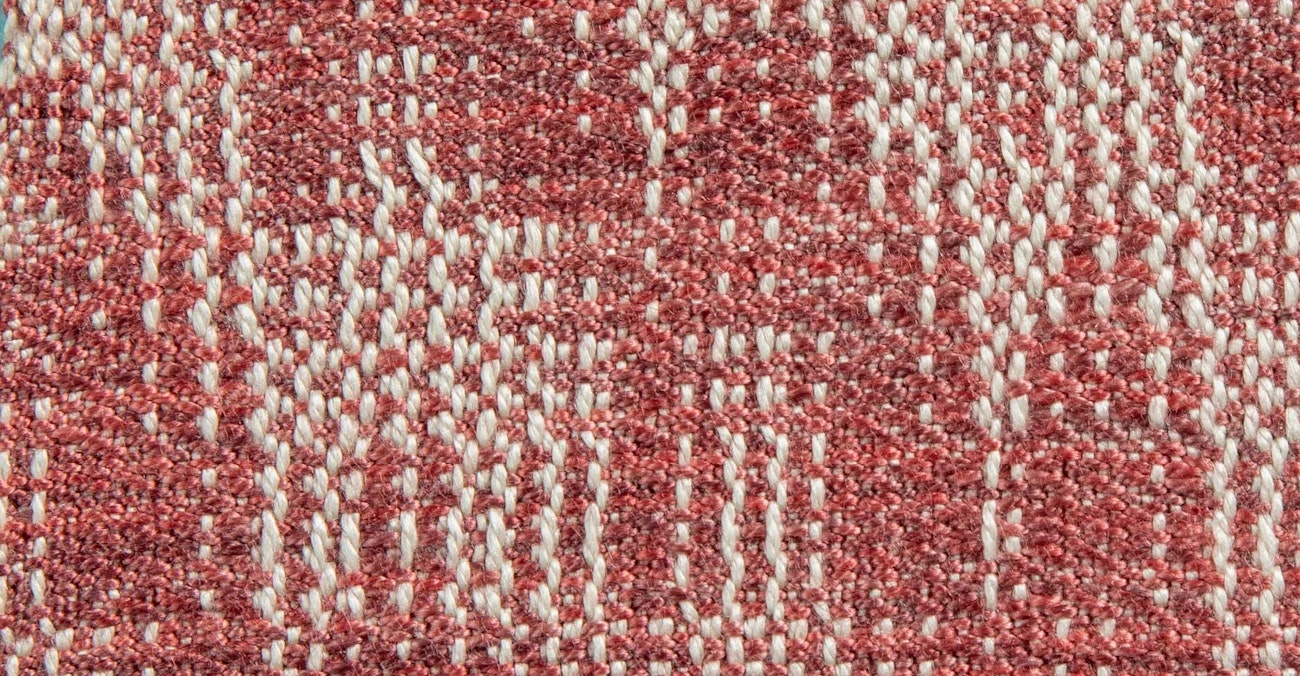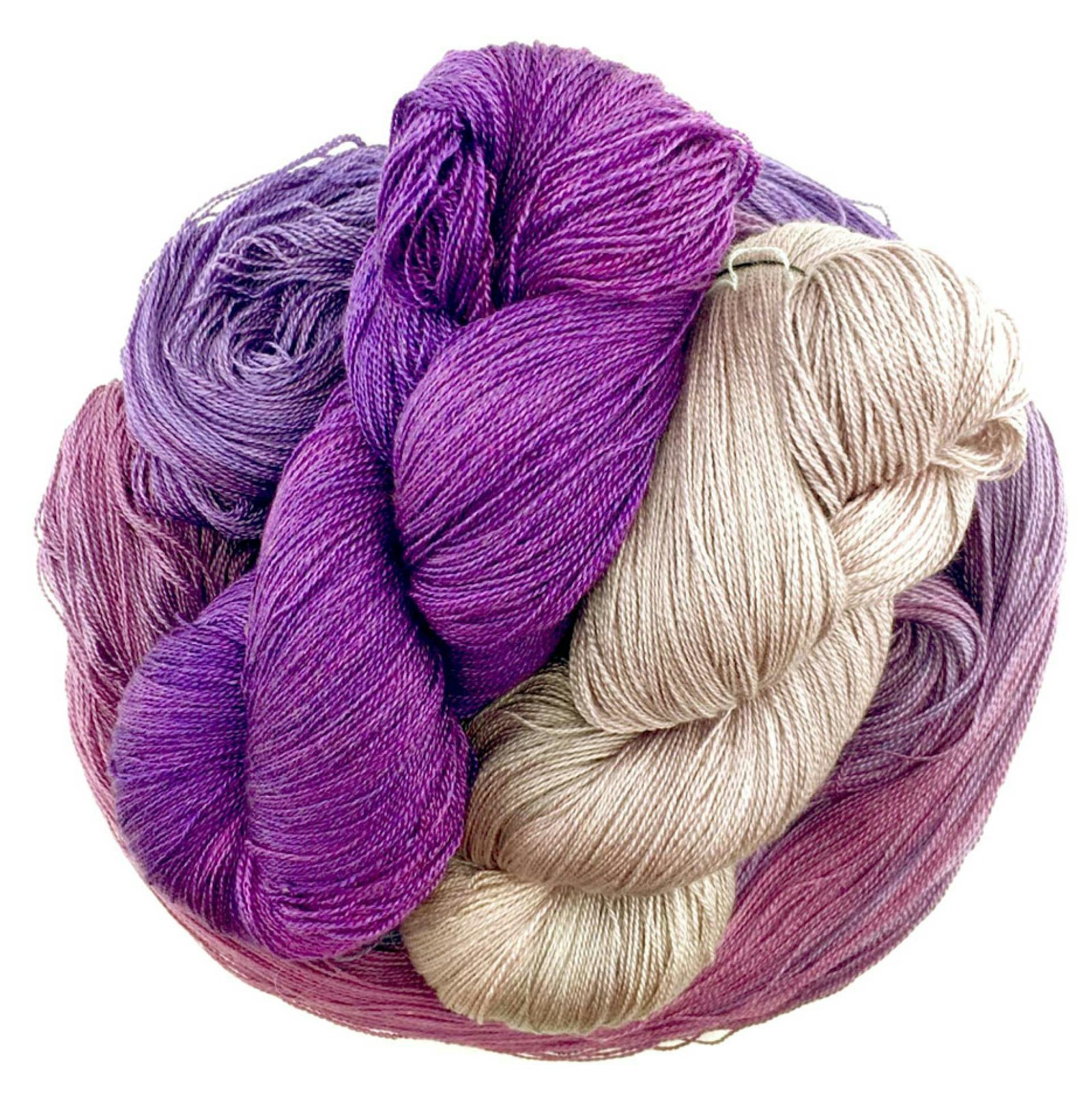For the Yarn Lab in Handwoven September/October 2020, Liz Moncrief sampled with a luxurious blend of Sea Silk and Merino wool. She even wove a beautiful scarf using the wool and sent it as part of her samples. It was wonderful and we ended up writing it up as a project so others could weave similar scarves. - Susan
THE YARN
Sea Silk, known officially as SeaCell, is a lyocell (rayon) product developed from seaweed. The lyocell process is a closed-loop system, with no chemicals released as waste—it’s also carbon-neutral and completely biodegradable. The seaweed rayon is embedded within a natural cellulose rayon; therefore, the 30% SeaCell product is actually a combination of seaweed and common rayon. The fiber is suitable for a vast range of applications, from sport and fashion clothing, underwear, and loungewear to home textiles, and combines easily with other fibers.
Marine Silk Lace is a mix of 51% silk, 29% merino wool, and 20% SeaCell. Henry’s Attic, a family-owned and -operated company specializing in high-quality yarns and fibers, imports the yarn to North America. Three years ago, I discovered Marine Silk Lace yarn at Fidalgo Artisan Yarn and Clothing, a small but thriving boutique yarn shop in Anacortes, Washington, where it was featured as a laceweight knitting yarn. I decided to try weaving with it to see if I could retain the luxurious hand and drape that I saw in the knitted garments. I spent several months contemplating how to handle it, and I believe I have accomplished my goal, though in a manner that surprised me. For this article, I re-created several of my test weave structures.

SAMPLE 1: Crackle
SAMPLE 1: Crackle
Sample Yarns: Warp: Natural; weft: Boysenberry Jam.
I first wanted to try a draft that I’d used for scarves and shawls that normally produced a fabric with a nice hand and drape. Unfortunately, with this yarn at this sett, I didn’t have the results I was hoping for. Perhaps if I had sett the warp looser it would have lightened the weave of the fabric. I used an undyed skein for the warp and a rusty red offered by the shop for the weft. The shop does its own dyeing, using an acid dye for the protein fibers.
Setts: 24 epi; 30 ppi.

SAMPLE 2: Advancing Twill
SAMPLE 2: Advancing Twill
Sample Yarns: Warp: Natural; weft: hand-dyed blue.
For this sample, I kept the sett at 24 ends per inch (epi) and balanced the weave with 24 picks per inch (ppi), giving the cloth about the same thickness as in Sample 1. The threading and tie-up combination resulted in a balanced weave and a cloth with nice drape. I think it would be perfectly acceptable for a scarf or a shawl. I chose to dye the weft yarn myself with a fiber-reactive dye. The yarn took color very consistently, and it’s good to know that home dyers can get results with either acid dyes, as used by Fidalgo, or fiber-reactive dyes.
Setts: 24 epi; 24 ppi.

SAMPLE 3: M’s and O’s
SAMPLE 3: M’s and O’s
Sample Yarns: Warp and weft: Natural.
Next, I wanted to try plain weave with occasional floats so I went to an M’s and O’s draft. The floats hug the fabric well, which indicates that overshot or another draft with long floats could also work nicely with this yarn. The plain weave of the fabric appears to be well- balanced, but the floats give it a ppi that is higher than I prefer.
Setts: 20 epi; 28 ppi.

SAMPLE 4: Broken Twill
SAMPLE 4: Broken Twill
Sample Yarns: Warp: Natural; weft: Smokey Grape.
I’ve often turned to this four-shaft diamond-patterned broken twill for an open weave. The draft is pleasing to the eye, and, unlike a typical tight twill fabric, it creates a light, open fabric. The break in both the threading and the treadling prohibit the weft from being too tightly packed. This sample has a pleasing hand and drape, making it ideal for scarves and shawls.
Setts: 22 epi; 24 ppi.

SAMPLE 5: Bronson Lace
SAMPLE 5: Bronson Lace
Sample Yarns: Warp: Natural; weft: Smokey Grape.
After weaving Marine Silk Lace in the broken twill, I wanted to try a very open weave to retain the soft nature of the yarn and to let it breathe even more. This is a simple weave structure, and I believe it would look even better when woven in natural-on-natural. It has a soft hand and would drape well for a scarf or a shawl, and, like the M’s and O’s sample, the floats seem to hug the cloth and don’t cause a snagging risk.
Setts: 18 epi; 20 ppi.

SAMPLE 6: Plain Weave
SAMPLE 6: Plain Weave
Sample Yarns: Warp and weft: Natural, Tawny, and Poseidon.
The final sample, a structure that has become my “go-to” whenever I use this yarn, may surprise you. The yarn is one of the best that I’ve ever used—it’s as soft as cashmere and has a beautiful halo. Ralph Waldo Emerson once said, “We ascribe beauty to that which is simple; which exactly answers its ends.” I believe that the simple effect of plain weave answers the beauty of this Marine Silk Lace. The plain weave is sett at an open 16 epi and is balanced, drapes well, and is heaven to touch. You’ll need an easy beat, but it’s so worth it.
Setts: 16 epi; 16 ppi.
Conclusions
The 100-gram dyed skeins might seem somewhat expensive at first glance, but, considering that these are luxury fibers and that the skeins hold a generous 882 yards, they are well worth it. Each skein has more than enough yarn for the warp and weft to make a lovely scarf. Marine Silk Lace washes like a dream with any mild detergent or shampoo. I found that all of my samples shrank only about 10 percent in both length and width. The yarn holds its twist well if you choose loose fringe, but twisted fringe is a nice finish to a scarf or shawl. Don’t you deserve to try the very best in your weaving? I guarantee that you’ll fall in love as I did.

